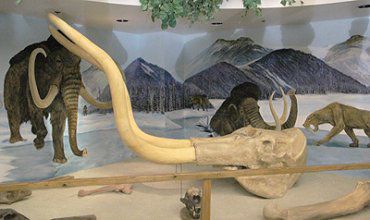The Emery County Historical Society was presented the story of the Huntington mammoth discovery in 1988 as filmed and photographed by Dawnette Tuttle. The meeting was held at the Museum of the San Rafael.
Museum Board Member Joyce Staley opened the meeting and introduced Holly Jorgensen as the entertainment and guest speakers Dawnette Tuttle, Tim Riley and Clifford Oviatt.
Jorgensen of Castle Dale sang an old song titled “Believe Me If All Those Endearing Young Charms” which provided a brief entertainment.
Tuttle described how she documented on videotape and made photographs of the excavation of the Huntington Mammoth. A Nielson Construction crew on US Forest Service land found the mammoth August 8, 1988 in a high mountain bog. Ira Hatch of the US Forest Service told Dawnette she could take pictures as long as she stayed out of the way. Following is her description of what it was like to see the mammoth in the ground, she showed her videos and photos, which provided excellent documentation of the excavation process. Tuttle said she really wanted to help with the digging. Her video covers from the beginning of the excavation, the preservation and the loading of the last bone into a pickup for transportation to the museum.
Several paleontologists came to the site and assisted in the excavation of this mammoth skeleton. Dave Gillett, state paleontologist at the time supervised the removing and preserving of the mammoth. It is believed this Columbian mammoth is a relative to the Woolly Mammoth but larger. The Mammoth had a broken leg and became trapped in the muddy bog about 10,000 years ago. The mammoth bones had been well preserved in that cold mud.
While the excavation of the Huntington Mammoth was going on the US Forest Service roped off the area and conducted tours around the skeleton for a week. More than 4,500 people came to see this exciting mammoth discovery.
At the 25th anniversary of finding the Huntington Mammoth, Tim Riley the Curator of Archaeology at the USU Pre Historic Museum in Price Utah requested Dawnette Tuttle bring her videos and photos to be shown at the museum.
Howard Tuttle of Johansen and Tuttle Engineering reported Nielson Construction in order to make the Huntington Reservoir dam more solid was digging out a big mud hole in the rebuilding process in August 1988 at about 9,000 feet above sea level. Chris Nielson, the backhoe operator, moved a shovelful of dirt and saw something unusual. He commented, “That is a funny looking log”, and asked supervising engineer Howard Tuttle to examine the object. Howard said he recognized the object as bone and joints. We hoped it was a mastodon and not a mammoth. If it had been a Mastodon we would not have had to shut down the job. Because the bones were those of a mammoth the job was shut down while the mammoth was excavated. The excavation took about a week. The US Forest Service had to be notified of the find because it was on their ground.
Tim Riley the Curator of Archaeology at the USU Pre Historic Museum in Price described the history of the Huntington Mammoth. He explained this short hair Columbian mammoth is like an elephant and larger than the woolly mammoth. The Huntington mammoth had a broken leg and may have been looking for a herd when it became stuck in the bog. This mammoth was found at near the 9,000 foot level which is unusual because the mammoth was known to be a plains animal. Riley said this is the most complete Columbian mammoth ever excavated. The Huntington mammoth is now on display at the USU Pre-historic Museum in Price. Copies of the mammoth bones have been sent to other museums for display around the world. Riley said other things found by the Huntington North Dam construction crew were a short faced bear mandible and arrowheads.
Artist Clifford Oviatt used poster board drawings and photographs to illustrate how he produced the Huntington mammoth mural for the museum. Clifford constructed from styrofoam the painted replica of the Huntington mammoth skull and tusks, which are on display in the Museum of the San Rafael.
Historical Society learns more about mammoth discovery

"The mammoth mural with the mammoth skull and tusk replica."
